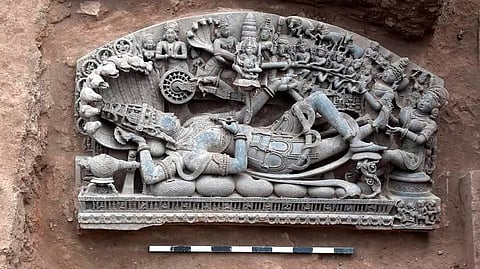Ancient 'Sheshshayi Vishnu' sculpture unearthed in Maharashtra's Sindkhed Raja
In a stunning archaeological revelation, an intricate 'Sheshshayi Vishnu' sculpture has been unearthed in Sindkhed Raja town in Maharashtra’s Buldhana District. Discovered on June 20 by the Archaeological Survey of India (ASI) during conservation work on Lakhuji Jadhavrao's Chhatri, this remarkable piece of ancient art dates back to the Hoysala period of South India. Found at a depth of 2.25 meters, it not only highlights the region's rich historical heritage but also exemplifies the exquisite craftsmanship of its time.
The Vishnu Sculpture carved from chlorite schist, features Dashavatara
The sculpture is an exquisite piece measuring 1.70 meters in length and 1 meter in height, carved from chlorite schist rock. This material, commonly used in South Indian Hoysala sculptures, is softer than the basalt rock typically found in Marathwada, explained iconography expert Saili Palande-Datar. The detailed panel features Lord Vishnu reclining on Shesha Naga, with Goddess Laxmi massaging his feet. The intricate carving also depicts the Samudramanthana, showcasing mythical jewels like Ashwa and Airavat, and the Dashavatara.
Arun Malik, Superintendent Archaeologist of Nagpur Circle, emphasised the uniqueness of the sculpture, highlighting the meticulous artistry involved in its creation. The panel also prominently features a donor couple situated between Sheshnaag and the Samudramanthana scene, adding to its distinctiveness.
Iconography expert Saili Palande-Datar noted that while similar sculptures have been found in Marathwada, they were crafted from basalt rock, making this chlorite schist sculpture a rare and valuable find.
Addition to Maharashtra's cultural gem!
The discovery of this 'Sheshshayi Vishnu' sculpture significantly enriches Maharashtra's cultural heritage and is poised to become a centrepiece in a future state art museum. This masterpiece not only highlights the region's artistic legacy but also offers new insights into ancient Indian art. As excavations continue, experts anticipate that the sculpture will captivate visitors with its intricate beauty and profound historical significance, solidifying its status as one of the museum's crown jewels.
To get all the latest content, download our mobile application. Available for both iOS & Android devices.

